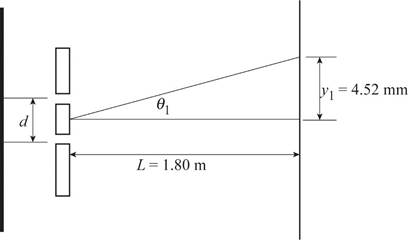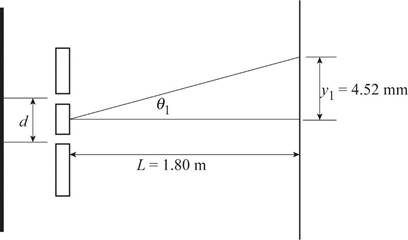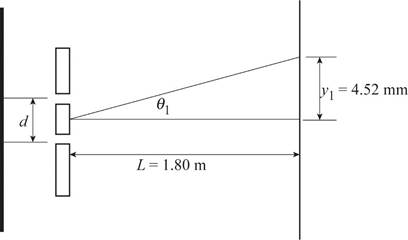
Concept explainers
Monochromatic
(a)
Answer to Problem 14P
Following figure shows the first bright fringe formation.

Explanation of Solution
Following figure shows the first bright fringe formation.

Here,
Conclusion:
Following figure shows the first bright fringe formation.

(b)
Answer to Problem 14P
Explanation of Solution
Given info:
The distance between the central maxima and the first bright fringe is
The screen separation is
Explanation:
Formula to calculate the tangent of the angle associated with the first order bright fringe is,
Substitute
Conclusion:
The tangent of the angle associated with the first order bright fringe is
(c)
Answer to Problem 14P
Explanation of Solution
Formula to calculate the angle associated with the first order bright fringe is,
Substitute
Formula to calculate the sine of the angle associated with the first order bright fringe is,
Substitute
The sine and the tangent of the angle are nearly same since the angle is very small. For larger angle the sine and tangent will not be comparable.
Conclusion:
The angle associated with the first fringe is
(d)
Answer to Problem 14P
Explanation of Solution
Given info:
The slit separation is
The order of first bright fringe is
Explanation:
Formula to calculate the wavelength is,
Here,
Substitute
Conclusion:
The wavelength of the light is
(e)
Answer to Problem 14P
Explanation of Solution
Given info:
The order of fifth bright fringe is
Explanation:
Formula to calculate the angle of fifth order bright fringe is,
Substitute
Conclusion:
The angle of the fifth order bright fringe is
(f)
Answer to Problem 14P
Explanation of Solution
Formula to calculate the position of the fifth bright fringe is,
Here,
Substitute
Conclusion:
The position of the fifth bright fringe on the screen is
Want to see more full solutions like this?
Chapter 24 Solutions
College Physics 11E Global Edition
 Principles of Physics: A Calculus-Based TextPhysicsISBN:9781133104261Author:Raymond A. Serway, John W. JewettPublisher:Cengage Learning
Principles of Physics: A Calculus-Based TextPhysicsISBN:9781133104261Author:Raymond A. Serway, John W. JewettPublisher:Cengage Learning University Physics Volume 3PhysicsISBN:9781938168185Author:William Moebs, Jeff SannyPublisher:OpenStax
University Physics Volume 3PhysicsISBN:9781938168185Author:William Moebs, Jeff SannyPublisher:OpenStax Glencoe Physics: Principles and Problems, Student...PhysicsISBN:9780078807213Author:Paul W. ZitzewitzPublisher:Glencoe/McGraw-Hill
Glencoe Physics: Principles and Problems, Student...PhysicsISBN:9780078807213Author:Paul W. ZitzewitzPublisher:Glencoe/McGraw-Hill Physics for Scientists and Engineers: Foundations...PhysicsISBN:9781133939146Author:Katz, Debora M.Publisher:Cengage Learning
Physics for Scientists and Engineers: Foundations...PhysicsISBN:9781133939146Author:Katz, Debora M.Publisher:Cengage Learning Modern PhysicsPhysicsISBN:9781111794378Author:Raymond A. Serway, Clement J. Moses, Curt A. MoyerPublisher:Cengage Learning
Modern PhysicsPhysicsISBN:9781111794378Author:Raymond A. Serway, Clement J. Moses, Curt A. MoyerPublisher:Cengage Learning Physics for Scientists and EngineersPhysicsISBN:9781337553278Author:Raymond A. Serway, John W. JewettPublisher:Cengage Learning
Physics for Scientists and EngineersPhysicsISBN:9781337553278Author:Raymond A. Serway, John W. JewettPublisher:Cengage Learning





